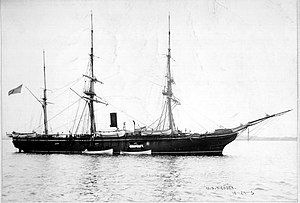USS Essex (1874)
 USS Essex circa 1895
|
|
| History | |
|---|---|
| Name: | USS Essex |
| Ordered: | 10 February 1873 |
| Commissioned: | 3 October 1876 |
| Struck: | 27 October 1930 |
| Fate: | Sold and burned for its metal |
| Status: | Remains exist along the shore of Minnesota Point. |
| General characteristics | |
| Type: | Steamer |
| Displacement: | 1,375 long tons (1,397 t) |
| Length: | 185 ft (56 m) |
| Beam: | 35 ft (11 m) |
| Draft: | 14 ft 3 in (4.34 m) |
| Propulsion: | Compound Steam engine, replaced in 1910 with a triple-expansion steam engine |
| Speed: | 10 knots (19 km/h; 12 mph) |
| Armament: |
|
| Notes: | Later given the classification number IX-10 |
|
USS Essex Shipwreck Site
|
|
| Built | 1876 |
| Architect | Donald McKay |
| NRHP Reference # | 94000342 |
| Added to NRHP | 14 April 1994 |
USS Essex, the third ship of that name, a wooden screw steamer, was built on contract for the United States by Donald McKay at East Boston, Massachusetts; commissioned at the Boston Navy Yard on 3 October 1876, Commander Winfield Scott Schley commanding; and reported to the North Atlantic Squadron.
During the following year Essex cruised to Liberia and along the west coast of Africa and in 1878-79 joined the South Atlantic Squadron. While at Monrovia, Liberia, on 31 October 1877, Ordinary Seaman John Millmore and First Class Fireman Henry Lakin Simpson rescued a shipmate from drowning, for which they were later awarded the Medal of Honor.Essex sailed on the Pacific Station from November 1881 to December 1882 and thence on the Asiatic Station for two years during which she took on board Captain S. H. Morrison and crew members of the shipwrecked Ranier. Following repairs' she returned to the Asiatic Station under command of Commander T.F. Jewell in June 1886 and in October anchored at Ponape, Caroline Islands, to afford protection to American missionaries during a native uprising. She returned to New York via the Suez Canal and was placed out of commission in May 1889.
Regarded as one of the finest ships of the fleet, Essex was designated next as a training ship. A three-month cruise with cadets at the Naval Academy at Annapolis in 1893 was followed by two lengthy tours to train naval apprentices (January 1894-April 1898, and September 1898 to December 1903.)
...
Wikipedia
